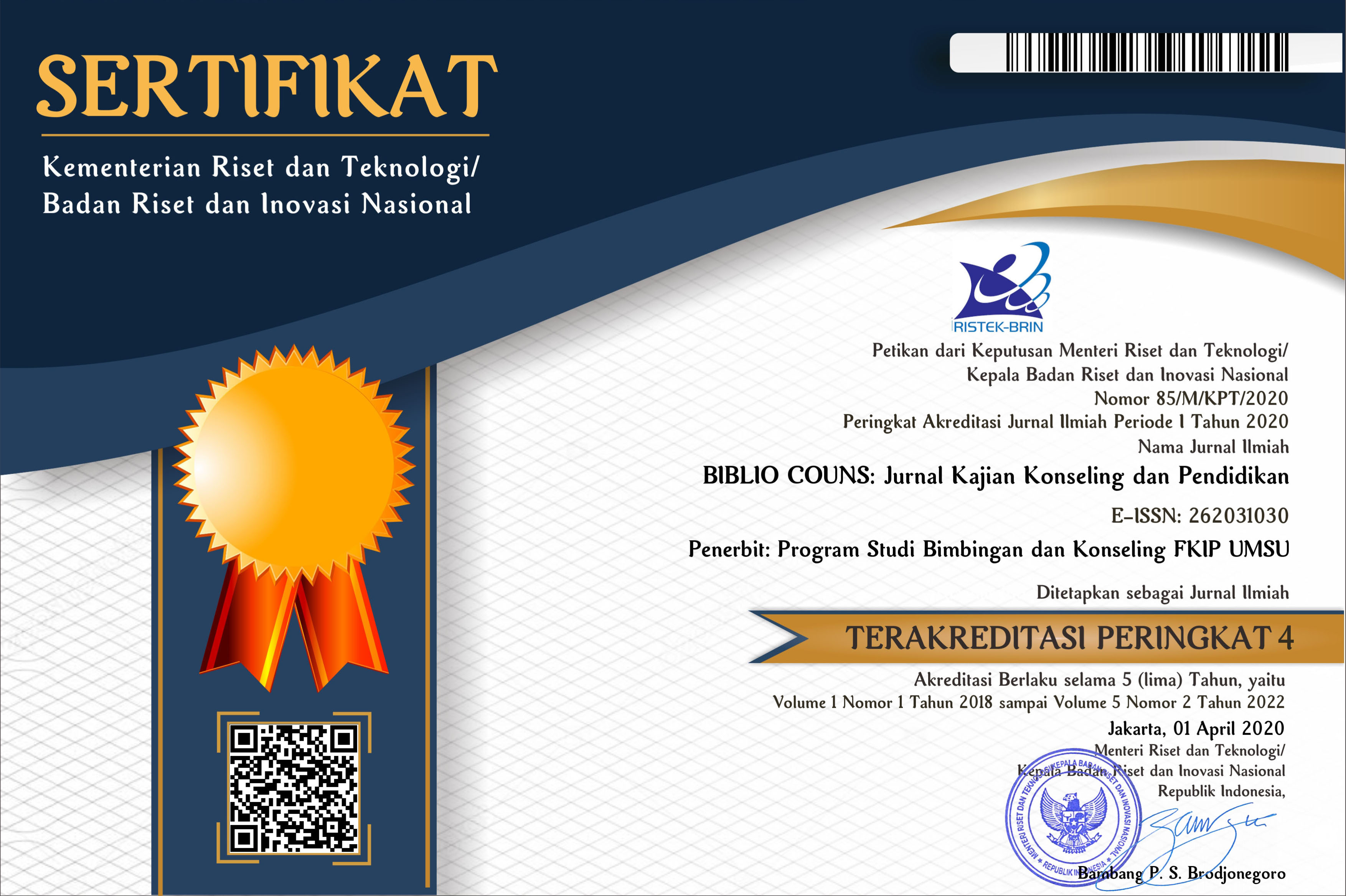Prosocial Behavior Based On Culture, Social Economic Conditions, And Gender
Abstract
Prosocial behavior is a voluntary act actualized in the attitude of getting rid of personal interests in providing benefits to other individuals. This study aims to analyze: To find out the description of prosocial behavior, to find out differences in prosocial behavior in terms of socio-economic conditions, to find out differences in students' prosocial behavior in terms of gender, to find out differences in students' prosocial behavior in terms of culture, and to find out differences in students' prosocial behavior. in terms of the interaction between culture, socio-economic conditions, gender. This type of research is a descriptive comparative research that uses comparative analysis techniques. The population of this research is the students of SMP Islam Hands as many as 123 people. The students who were used as samples in this study were 123 people. The instrument used is a Likert scale. Hypothesis testing in research to see differences in prosocial behavior in terms of socioeconomic status, gender and majors will use a three-way Analysis of Variance (ANOVA).
Keywords
Full Text:
PDFReferences
Abdullahi, I., & Kumar, P. (2016). Gender Differences in Prosocial Behaviour. International Journal of Indian Psychology, 3, 171175.
Akbar, U. &. (2014). Pengantar Statistika. Jakarta: PT Bumi Aksara.
Baron, R. A. & Byrne, D. (2003). Psikologi Sosial. Jakarta: Erlangga.
Bullock, L. M., Wong-Lo, M., & Gable, R. A. (2010). Peer Relations and Socialization of Children and Adolescents with Special Needs (P. Peterson, E. Baker, & B. B. T.-I. E. of E. (Third E. McGaw, eds.). https://doi.org/https://doi.org/10.1016/B978-0-08-044894-7.01131-3
Davidoff, L. L. (1991). Psikologi Suatu Pengantar Terjemahan oleh Marijuniati (2nd ed.). Jakarta.
Declerck, C., & Boone, C. (2016). Chapter 2 - The Neuroanatomy of Prosocial Decision Making: The Role of Valuation, Cognitive Control, and Social Cognition (C. Declerck & C. B. T.-N. of P. B. Boone, eds.). https://doi.org/https://doi.org/10.1016/B978-0-12-801303-8.00002-1
Dovidio, J. (2001). Adulthood: Prosocial Behavior and Empathy (N. J. Smelser & P. B. B. T.-I. E. of the S. & B. S. Baltes, eds.). https://doi.org/https://doi.org/10.1016/B0-08-043076-7/01740-X
Espinosa, M. P., & Kovarik, J. (2015). Prosocial behavior and gender. Frontiers in Behavioral Neuroscience, 9, 88. https://doi.org/10.3389/fnbeh.2015.00088
Fabes, R. A., Carlo, G., Kupanoff, K., & Laible, D. (1999). Early adolescence and prosocial/moral behavior I: The role of individual processes. Journal of Early Adolescence, 19(1), 516. https://doi.org/10.1177/0272431699019001001
Fabes, R. a., & Eisenberg, N. (1998). Meta-analyses of age and sex differences in childrens and adolescents prosocial behavior. Retrieved May, 129. Retrieved from http://www.public.asu.edu/~sparky00/fabes/meta.pdf
Futamura, I. (2018). Is extraordinary prosocial behavior more valuable than ordinary prosocial behavior? PLoS ONE, 13(4), 115. https://doi.org/10.1371/journal.pone.0196340
Heffetz, O., & Frank, R. H. (2011). Chapter 3 - Preferences for Status: Evidence and Economic Implications**We thank Catherine Eckel, Ada Ferrer-i-Carbonell, Chaim Fershtman, and Andrew Oswald for useful conversations, comments, and references, and Russell Toth for excellent research assist (J. Benhabib, A. Bisin, & M. O. B. T.-H. of S. E. Jackson, eds.). https://doi.org/https://doi.org/10.1016/B978-0-444-53187-2.00003-6
Hepach, R., & Herrmann, E. (2019). The Development of Prosocial Attention Across Two Cultures. 10(February), 111. https://doi.org/10.3389/fpsyg.2019.00138
Iqbal, F. (2013). Prosocial Behavior in Different Situations among Men and Women. IOSR Journal of Humanities and Social Science, 8(6), 3140. https://doi.org/10.9790/0837-0863140
Irianto, A. (2010). Statistika Konsep, Dasar, Aplikasi, dan Pengembangannya. Jakarta: Kencana Prenada Media Group.
Istiana. (2016). Hubungan Empati Dengan Perilaku Prososial Pada. Jurnal DIVERSITA, 2(2), 113.
Klein, N. (2017). Prosocial behavior increases perceptions of meaning in life. Journal of Positive Psychology, 12(4), 354361. https://doi.org/10.1080/17439760.2016.1209541
Kster, M., Schuhmacher, N., & Krtner, J. (2015). A CULTURAL PERSPECTIVE ON PROSOCIAL DEVELOPMENT. 7182.
Lampridis, E., & Papastylianou, D. (2017). Prosocial behavioural tendencies and orientation towards individualismcollectivism of Greek young adults. International Journal of Adolescence and Youth, 22(3), 268282. https://doi.org/10.1080/02673843.2014.890114
Leary, M. R. (2001). Impression Management, Psychology of (N. J. Smelser & P. B. B. T.-I. E. of the S. & B. S. Baltes, eds.). https://doi.org/https://doi.org/10.1016/B0-08-043076-7/01727-7
Megawati, E., Psikologi, P. S., Kedokteran, F., & Udayana, U. (2015). HUBUNGAN ANTARA PERILAKU PROSOSIAL DENGAN PSYCHOLOGICAL WELL-BEING PADA REMAJA MOTTO.
Meier, S. (2011). A Survey of Economic Theories and Field Evidence on Pro-Social Behavior. SSRN Electronic Journal, (06). https://doi.org/10.2139/ssrn.917187
Nurhaidah, & Musa, M. I. (2015). Dampak Pengaruh Globalisasi Bagi Kehidupan Bangsa Indonesia. Jurnal Pesona Dasar, 3(3), 114.
Piliavin, J. A. (2001). Altruism and Prosocial Behavior, Sociology of (N. J. Smelser & P. B. B. T.-I. E. of the S. & B. S. Baltes, eds.). https://doi.org/https://doi.org/10.1016/B0-08-043076-7/01826-X
Putra, H. P., Gistituati, N., & Syahniar, S. (2015). Peningkatan Perilaku Prososial Siswa di Sekolah melalui Layanan Bimbingan Kelompok dengan Teknik Modeling. Jurnal Konseling Dan Pendidikan, 3(2), 31. https://doi.org/10.29210/112700
Rini Lestari. (2016). TRANSMISI NILAI PROSOSIAL PADA REMAJA JAWA. Jurnal Indigenous, 1(2), 3344. https://doi.org/2541450X
Santrock, J. W. (2012). Life-Span Development (Perkembangan Masa Hidup Edisi 13 Jilid 1, Penerjemah: Widyasinta,B). Jakarta: Erlangga.
Sears, D. O. (1991). Psikologi Sosial (Jilid 2). Jakarta: Mawar Gempita.
Skoe, E. E. A., Cumberland, A., Eisenberg, N., Hansen, K., & Perry, J. (2002). The Influences of Sex and Gender-Role Identity on Moral Cognition and Prosocial Personality Traits. Sex Roles, 46(9), 295309. https://doi.org/10.1023/A:1020224512888
Sudijono. (2014). Pengantar Statistik Pendidikan. Jakarta: Raja Grafindo: Persada.
Sudjana. (2002). Metode Statistika. Bandung: Tarsito.
Sugiyono. (2008). Metode Penelitian Pendidikan. Bandung: CV. Alfabeta.
Sumarwan, U. (2011). erilaku Konsumen Teori dan Penerapannya dalam Pemasaran. Bogor: Ghalia Indonesia.
Supardi. (2012). Penelitian Tindakan Kelas. Jakarta: PT Bumi Aksara.
Suseno, F. M. (1996). Etika Jawa : Sebuah Analisa Tentang Kebijaksanaan Hidup Jawa. Jakarta: PT. Gramedia.
Tulus, W. (2002). Statistik dalam Penelitian Psikologi dan Pendidikan. Malang: UMM Press.
Van der Graaff, J., Carlo, G., Crocetti, E., Koot, H. M., & Branje, S. (2018). Prosocial Behavior in Adolescence: Gender Differences in Development and Links with Empathy. Journal of Youth and Adolescence, 47(5), 10861099. https://doi.org/10.1007/s10964-017-0786-1
van Dijk, E. (2015). The economics of prosocial behavior. In Oxford Library of Psychology. The Oxford handbook of prosocial behavior. (pp. 8699). New York, NY, US: Oxford University Press.
Yusuf, A. M. (2013). Metode Kuantitatif, Kualitatif dan Penelitian Gabungan. Padang: UNP Press.
DOI: https://doi.org/10.30596/bibliocouns.v4i2.6246
Refbacks
- There are currently no refbacks.
Biblio Couns: Jurnal Kajian Konseling dan Pendidikan
Universitas Muhammadiyah Sumatera Utara
Kampus Utama
Jl. Kapten Muchtar Basri No.3, Glugur Darat II,Medan
Sumatera Utara-20238
E-mail: jbcons@umsu.ac.id



